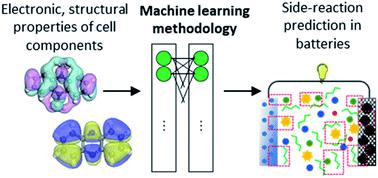当前位置:
X-MOL 学术
›
Chem. Sci.
›
论文详情
Our official English website, www.x-mol.net, welcomes your
feedback! (Note: you will need to create a separate account there.)
Predicting the chemical reactivity of organic materials using a machine-learning approach
Chemical Science ( IF 7.6 ) Pub Date : 2020-07-03 , DOI: 10.1039/d0sc01328e Byungju Lee 1, 2, 3, 4, 5 , Jaekyun Yoo 1, 2, 3, 4, 5 , Kisuk Kang 1, 2, 3, 4, 5
Chemical Science ( IF 7.6 ) Pub Date : 2020-07-03 , DOI: 10.1039/d0sc01328e Byungju Lee 1, 2, 3, 4, 5 , Jaekyun Yoo 1, 2, 3, 4, 5 , Kisuk Kang 1, 2, 3, 4, 5
Affiliation

|
Stability and compatibility between chemical components are essential parameters that need to be considered in the selection of functional materials in configuring a system. In configuring devices such as batteries or solar cells, not only the functionality of individual constituting materials such as electrodes or electrolyte but also an appropriate combination of materials which do not undergo unwanted side reactions is critical in ensuring their reliable performance in long-term operation. While the universal theory that can predict the general chemical reactivity between materials is long awaited and has been the subject of studies with a rich history, traditional ways proposed to date have been mostly based on simple electronic properties of materials such as electronegativity, ionization energy, electron affinity and hardness/softness, and could be applied to only a small group of materials. Moreover, prediction has often been far from accurate and has failed to offer general implications; thus it was practically inadequate as a selection criterion from a large material database, i.e. data-driven material discovery. Herein, we propose a new model for predicting the general reactivity and chemical compatibility among a large number of organic materials, realized by a machine-learning approach. As a showcase, we demonstrate that our new implemented model successfully reproduces previous experimental results reported on side-reactions occurring in lithium–oxygen electrochemical cells. Furthermore, the mapping of chemical stability among more than 90 available electrolyte solvents and the representative redox mediators is realized by this approach, presenting an important guideline in the development of stable electrolyte/redox mediator couples for lithium–oxygen batteries.
中文翻译:

使用机器学习方法预测有机材料的化学反应性
化学成分之间的稳定性和兼容性是在配置系统时选择功能材料时需要考虑的基本参数。在配置诸如电池或太阳能电池之类的设备时,不仅要确保诸如电极或电解质之类的各个构成材料的功能,而且还要确保不会发生不良副反应的材料的适当组合对于确保其长期运行的可靠性能至关重要。可以预测材料之间一般化学反应性的通用理论是人们期待已久的,并且已成为历史悠久的研究对象,但迄今为止提出的传统方法主要是基于材料的简单电子性质,例如电负性,电离能,电子亲和力和硬度/柔软度,并且只能应用于一小部分材料。此外,预测往往远非准确,无法提供一般性含义。因此,这实际上不足以作为大型材料数据库中的选择标准,即数据驱动的材料发现。在这里,我们提出了一种新的模型,用于通过机器学习方法来预测大量有机材料之间的一般反应性和化学相容性。作为展示,我们证明了我们新实施的模型成功地再现了先前报道的有关锂氧电化学电池中发生的副反应的实验结果。此外,通过这种方法可以实现90多种可用电解质溶剂和代表性氧化还原介体之间的化学稳定性映射,为开发用于锂氧电池的稳定电解质/氧化还原介体对提供了重要指导。
更新日期:2020-08-05
中文翻译:

使用机器学习方法预测有机材料的化学反应性
化学成分之间的稳定性和兼容性是在配置系统时选择功能材料时需要考虑的基本参数。在配置诸如电池或太阳能电池之类的设备时,不仅要确保诸如电极或电解质之类的各个构成材料的功能,而且还要确保不会发生不良副反应的材料的适当组合对于确保其长期运行的可靠性能至关重要。可以预测材料之间一般化学反应性的通用理论是人们期待已久的,并且已成为历史悠久的研究对象,但迄今为止提出的传统方法主要是基于材料的简单电子性质,例如电负性,电离能,电子亲和力和硬度/柔软度,并且只能应用于一小部分材料。此外,预测往往远非准确,无法提供一般性含义。因此,这实际上不足以作为大型材料数据库中的选择标准,即数据驱动的材料发现。在这里,我们提出了一种新的模型,用于通过机器学习方法来预测大量有机材料之间的一般反应性和化学相容性。作为展示,我们证明了我们新实施的模型成功地再现了先前报道的有关锂氧电化学电池中发生的副反应的实验结果。此外,通过这种方法可以实现90多种可用电解质溶剂和代表性氧化还原介体之间的化学稳定性映射,为开发用于锂氧电池的稳定电解质/氧化还原介体对提供了重要指导。










































 京公网安备 11010802027423号
京公网安备 11010802027423号